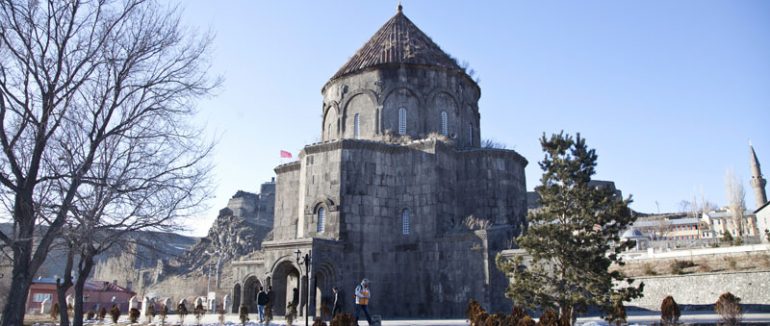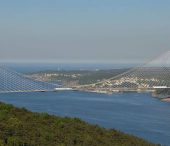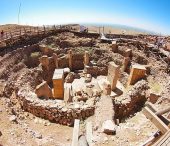Kars is a city in northeast Turkey and the capital of Kars Province. Population: 142,145 (1990); 130,361 (2000), 292,666 (2015)
History
The early history of Kars is little known, beyond the fact that it had its own dynasty of Armenian rulers and was the capital of a region known as Vanand. At some point in the 9th century (at least by 888) it became part of the territory of the Armenian Bagratids. For a short time (from 928 to 961) Kars became the capital of their kingdom. It was during this period that the Cathedral, later known as the Church of the Apostles, was built.
In 963, shortly after the Bagratid capital was transferred to Ani, Kars became the capital of a separate independent kingdom, again called Vanand. However, the extent of its actual independence from the Kingdom of Ani is uncertain. For example, it was always held by relatives of the rulers of Ani, and after Ani's capture by the Byzantine Empire in 1045 the Bagratid royal title "King of Kings" held by the ruler of Ani was transferred to the ruler of Kars.
In 1064, just after the capture of Ani by the Seljuk Turks, the last Armenian king of Kars, Gagik II, paid homage to the victorious Turks to avoid them laying siege to his city. In 1065 Gagik ceded control of Kars to the Byzantine Empire, but soon afterwards they lost it to the Seljuk Turks. In 1206/1207 the city was captured by the Georgians and given to the same Zakarid family who ruled Ani. They retained control of Kars until the late 1230s, after which it was ruled by a series of petty Turkish emirs.
In 1387 the city surrendered to Timur (Tamerlane) and its fortifications were slighted. More petty Turkish emirs followed until 1534, when the Ottoman army captured the city. The fortifications of the city were rebuilt by the Ottoman Sultan Murad III and were strong enough to withstand a siege by Nadir Shah of Persia, in 1731. It became the head of a sanjak in the Turkish vilayet of Erzurum.
In 1807 it successfully resisted the Russians, but after another siege in 1828 it was surrendered on June 23, 1828 to the Russian general Count Ivan Paskevich, 11,000 men becoming prisoners of war. Although it was afterwards returned to Turkey, the new border between Turkey and Russia lay much closer to Kars. During the Crimean War the Turkish garrison, led by General William Fenwick Williams and other foreign officers, kept the Russians at bay during a protracted siege; but after the garrison had been devastated by cholera and food had utterly failed, nothing was left but to surrender to General Mouravieff in November 1855.
The fortress was again stormed by the Russians in the Battle of Kars during the Russo-Turkish War, 1877-78 under generals Loris-Melikov and Ivan Lazarev and on its conclusion was transferred to Russia by the Treaty of San Stefano. Kars became the capital of Kars Oblast (province), comprising the districts of Kars, Ardahan, Kağızman, and Oltu.
After the subjection to Russia more than 82000 Muslims emigrated to Turkey within the period of 1878-1881, of them more than 11 000 left the city itself. At the same time, many Armenians, Greeks and Russians migrated to the region from other regions of Turkey and Transcaucasia. According to the Russian census data, by 1892 Russians made 7%, Greeks 13.5%, Kurds 15%, Armenians 21,5%, Turks 24%, Karapapakhs 14%, and Turkmen 5% of the population of Kars oblast of the Russian empire.
In the First World War, the city became one of the main objectives of the Ottoman army during the Battle of Sarıkamış in the Caucasus Campaign.
Russia ceded Kars, Ardahan and Batum to the Ottoman Empire under the Treaty of Brest-Litovsk on March 3, 1918. However, by then Kars was under the effective control of Armenian and non-Bolshevik Russian forces. The Ottoman empire captured Kars on April 25, 1918 and the Republic of Southwest Caucasus was established in the zone, but when the Armistice of Mudros (October 1918) was established the Ottoman army was required to withdraw to the 1914 frontiers. The British occupied Batumi but the Ottomans refused to relinquish Kars; its military governor instead constituting a provisional government led by Fahrettin Pirioglu that claimed Turkish sovereignty over Kars and the Turkish-speaking and Islamic neighbouring regions as far as Batumi and Alexandropol (Gyumri). The region was occupied by the Democratic Republic of Armenia (DRA) in January 1919 but the pro-Turkish government remained in the city until the arrival of the British troops, who dissolved it on April 19, 1919, sending its leaders to Malta. May 1919, Kars came under full administration of the DRA and became the capital of the Vanand province (named after the historic Armenian region that the city was once the capital of).
Throughout all the obstacles of Kars, a heroic leader, priest and renaissance man by the name of Ter Hovhaness Avak Dourian Hadjian, was essential in the preservation of Kars and has published a biography on his life and the events surrounding Kars. He has also writings in his personal collection, "The Last Days of Kars"(Karsi Verchin Orere) and many other diaries.
However, skirmishes between Turkish revolutionaries and Armenian border troops in Oltu, led to an invasion of the DRA by four Turkish battalions under the command of General Kazım Karabekir, thus triggering the Turkish-Armenian War. The Turkish-Armenian War led to the capture of Kars by Turkish forces on October 30, 1920. The terms of the Treaty of Alexandropol, signed by the representatives of Armenia and Turkey on December 2, 1920, forced the DRA to cede more than 50% of its pre-war territory and to give up all the territories granted to it at the Treaty of Sèvres. However, with the Bolshevik invasion of Armenia, the Alexandropol treaty was superseded by the Treaty of Kars (October 23, 1921), signed between Turkey and the newly-established Soviet Union. The treaty allowed for Soviet annexation of Adjara in exchange for Turkish control over the regions of Kars, Iğdır, and Ardahan. The treaty established peaceful relations between the two nations, but as early as 1939, some British diplomats noted indications that the Soviet Union was not satisfied with the established border. On more than one occasion, the Soviets attempted to renegotiate with Turkey to at least allow the Armenians access to the ancient ruins of Ani. However, Ankara refused these attempts.
After World War II, the Soviet Union attempted to annul the Kars treaty and regain its lost territory. On June 7, 1945, Soviet Foreign Minister Vyacheslav Molotov told the Turkish ambassador in Moscow that the regions should be returned to the Soviet Union, in the name of both the Georgian and Armenian republics. Turkey found itself in a difficult position: it wanted good relations with the Soviet Union but at the same time they refused to give up the territories. Turkey itself was in no condition to fight a war with the Soviet Union which had emerged as a superpower after the second world war. By the autumn of 1945, Soviet troops in the Caucasus were already assembling for a possible invasion of Turkey. However opposition stemmed from British leader Winston Churchill who objected to these territorial claims as additional areas of where the Soviet government could exert its influence while President Harry S. Truman of the United States felt that matter shouldn't concern other parties. The Cold War was just beginning.
Since the Nagorno-Karabakh War, the borders between Armenia and Turkey have been closed. Kars Mayor Naif Alibeyoğlu, believes that the border should be opened again and that there should be no nationalist sentiment against the Armenians.
Kars Citadel
Kars Castle (Kars Kalesi) also known as the Kars citadel) sits at the top a rocky hill overlooking Kars. Its walls date back to the Bagratid Armenian period (there is surviving masonry on the north side of the castle) but it probably took on its present form during the 13th century when Kars was ruled by the Zakarid dynasty. The walls bear crosses in several places, including a khachkar with a building inscription in Armenian on the easternmost tower, so the much repeated statement that Kars kastle was built by Ottoman Sultan Murad III during the war with Persia, at the close of the 16th century, is false. However, Sultan Murad probably did reconstruct much of the city walls (they are similar to those that the Ottoman army constructed at Ardahan).
Other Historical Structures
The church of the Apostles, built in the 9th century.Below the castle is an Armenian church known as the St. Arak'elos Cathedral, the Church of the Apostles. Built in the 10th century, it constitutes a domed tetraconch atop a square base with four apses. The drum of the dome features bas relief depictions of The Twelve Apostles and the dome itself is covered by a conical roof. It housed a small museum in the 1960s and 1970s, then stood derelict for about two decades until its conversion into a mosque in 1998.
As a settlement at the juncture of Armenian, Caucasian, Russian, and Turkish cultures, the buildings of Kars come in a variety of architectural styles.
Kars in popular culture
The philosopher and mystic G. I. Gurdjieff grew up in Kars.
The Armenian poet Yeghishe Charents was born in Kars.
Kars is the setting of the novel Kar (Snow) by Orhan Pamuk.
Anna Zimmerman, maternal grandmother of American folk singer Bob Dylan (born Robert Allen Zimmerman) grew up in the area around Kars.
The actress Hülya Avşar has a familial relation with Kars.
The actor Tamer Karadağlı was born in Kars.










